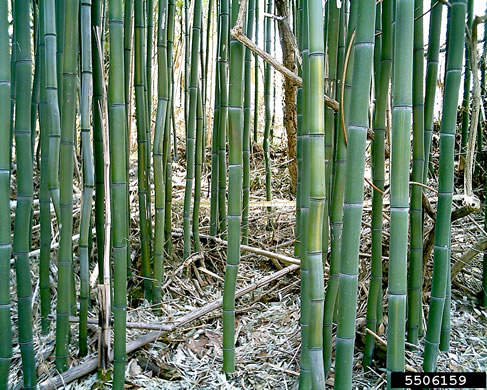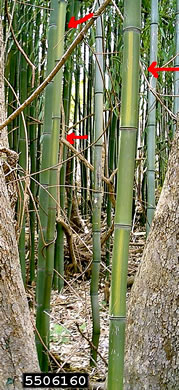Spermatophytes (seed plants): Angiosperms (flowering plants): Monocots: Commelinids: Poales
WEAKLEY'S FLORA OF THE SOUTHEASTERN US (4/14/23):
Phyllostachys aureosulcata
FAMILY
Poaceae
Go to FSUS key
Dig deeper at SERNEC, a consortium of southeastern herbaria.
Check out EDDMapS.org to see where this has been reported.
SYNONYMOUS WITH
PLANTS NATIONAL DATABASE:
Phyllostachys aureosulcata
FAMILY
Poaceae
SYNONYMOUS WITH Floristic Synthesis of North America. BONAP (Kartesz, 2021)
Phyllostachys aureosulcata
SYNONYMOUS WITH Floristic Synthesis of North America (Kartesz, 1999)
Phyllostachys aureosulcata
COMMON NAME:
Yellowgroove Bamboo
To see larger pictures, click or hover over the thumbnails.
Caryn Rickel, Institute of Invasive Bamboo Research, Bugwood.org bug_5506159
April CT
Pemberwick Park
Lower portion of culm may be geniculate (zigzag) at the nodes, per Woody Plants of the Southeastern US: A Winter Guide (Lance, 2004).
Caryn Rickel, Institute of Invasive Bamboo Research, Bugwood.org bug_5506160
April CT
Pemberwick Park
Red arrows indicate faint yellow groove on every other internode, per www.invasive.org.
Caryn Rickel, Institute of Invasive Bamboo Research, Bugwood.org bug_5475474
Month Unknown CT
Culms usually 2-4cm diameter, potentially to about 10m tall, per Woody Plants of the Southeastern US: A Winter Guide (Lance, 2004).
WEAKLEY'S FLORA OF THE SOUTHEASTERN US (4/14/23):
Phyllostachys aureosulcata
FAMILY
Poaceae
SYNONYMOUS WITH
PLANTS NATIONAL DATABASE:
Phyllostachys aureosulcata
FAMILY
Poaceae
SYNONYMOUS WITH
Floristic Synthesis of North America. BONAP (Kartesz, 2021)
Phyllostachys aureosulcata
SYNONYMOUS WITH
Floristic Synthesis of North America (Kartesz, 1999)
Phyllostachys aureosulcata
If a search such as "Carex leptalea var. leptalea" doesn't deliver the results you want, try "Carex leptalea".
Or, to minimize chances of a misspelling, try just "Carex le".
Less is more: If "pencil flower" doesn't deliver the results you want, try "pencil".




